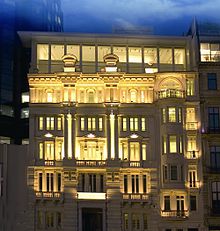İstiklal Avenue
| Grand Avenue of Pera | |
Istanbul Province, Turkey | |
| Coordinates | 41°02′03.0″N 28°58′44.0″E / 41.034167°N 28.978889°E |
|---|---|
İstiklal Avenue (
The street starts at the northern end of
Galatasaray Square marks the middle of the avenue and is home to the oldest secondary school in Turkey: the Galatasaray High School (Galatasaray Lisesi), originally known as the Galata Sarayı Enderun-u Hümayunu (Galata Palace Imperial School). A monument, erected in 1973, commemorates the 50th anniversary of the founding of the Turkish Republic.

The avenue forms a spine with narrow side streets running off it like a ribcage. Many historical and politically significant buildings can be found on or immediately adjacent to Istiklal Avenue. They include the


At the southern end of the avenue, it is possible to board the
History
During the
On 6–7 September 1955 an
Between the 1950s and 1970s the side streets around the Emek Pasajı were home to Yeşilcam, Turkey's home-grown equivalent of Hollywood, a fact commemorated in the street name Yeşilcam Sokağı.[citation needed]

The avenue fell from grace in the 1970s and 1980s as the old Istanbulite inhabitants moving elsewhere, and the side streets (then infamous for bars and night clubs with live music and shows, called pavyon in Turkish) were repopulated by migrants from rural Anatolia.

During the late 1980s and early 1990s, a revival took place, spearheaded and executed by the Istanbul Metropolitan Municipality and Beyoğlu Municipality. Historic buildings were restored, the street was pedestrianised, and the old historic trams were reinstated, bringing back much of the avenue's old charm and popularity.

İstiklal Avenue became the center for fine arts and leisure in Istanbul once again and real estate prices skyrocketed. Numerous new art galleries, bookstores, cafés, pubs, restaurants, shops and hotels were opened in and around the street, and venues around it became the host to many international art festivals, such as the annual
Until the mid-2010s, İstiklal Avenue was also a popular venue for all sorts of parades, marches and gatherings, such as the Istanbul Pride and International Women's Day. However, after the Gezi Park protests of 2013, all such gatherings have been effectively banned, citing security reasons.
On 19 March 2016, an Islamic State suicide bombing on Istiklal Avenue killed five people.[2][3][4]
On 13 November 2022, a
Notable buildings


- Religious buildings
- Church of Sant'Antonio di Padova
- Hagia Triada Greek Orthodox Church
- Church of Santa Maria Draperis
- Hüseyin Ağa Mosque
- Schools
- Historic buildings and residences
- Old Galatasaray Post Office
- Rumeli Pasajı (Cité Roumelie)
- Hazzopulo Pasajı
- Mısır Apartments
- Casa Botter, one of the finest examples of Art Nouveau architecture in Istanbul
- Grand Pera, home in the past to the Cercle d'Orient and now to Madame Tussauds Istanbul
- Tokatliyan Han, once home to the Grand Tokatliyan Hotel
- Food and drink
- Çiçek Pasajı (Cité de Péra), site of the Naum Theatre until 1870
- Lebon Patisserie & Café, a defunct historic pastry shop and café
- Markiz Pastanesi, a renowned historic pâtisserie and chocolaterie
- Narmanlı Han, originally home to the Russian Embassy, later home to artist Aliye Berger, today houses cafés and restaurants
- Diplomatic missions
- Dutch Consulate
- French Consulate
- Greek Consulate
- Russian Consulate
- Swedish Consulate
- Culture and arts
- Istanbul Cinema Museum
- Yapı Kredi Art Gallery
- Beyoğlu Sanat Galerisi
- Akbank Sanat Galerisi
- SALT Beyoğlu
- Meşher Art Gallery
See also
- Abdi İpekçi Avenue
- Bağdat Avenue
- List of upscale shopping districts
References
- ^ Binnaz Tugba Sasanlar. A Historical Panorama of an Istanbul Neighborhood: Cihangir from the Late Nineteenth Century to the 2000s Archived 2012-12-10 at the Wayback Machine Bogaziçi University. 2006
- ^ "Istanbul shopping area hit by suicide bomber". BBC. 19 March 2016.
- ^ "Istanbul explosion: Suicide bomber had ISIS links, says Turkey's interior minister". CNN. 20 March 2016. Archived from the original on 18 August 2016. Retrieved 25 July 2016.
- ^ "Istanbul explosion: At least five dead as tourist shopping area Istiklal Street hit by suicide bombing in Turkey". The Independent. 19 March 2016. Archived from the original on 2 May 2019. Retrieved 4 December 2017.
- ^ "Turkey: Several killed and wounded after explosion hits Istanbul's busy Istiklal street". Middle East Eye. Retrieved 2022-11-13.
- ^ "Woman Who Planted Bomb In Istanbul That Killed 6 People Arrested By Turkish Police".
